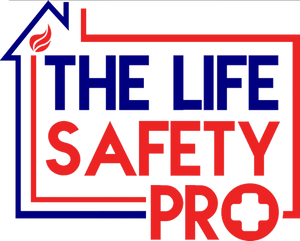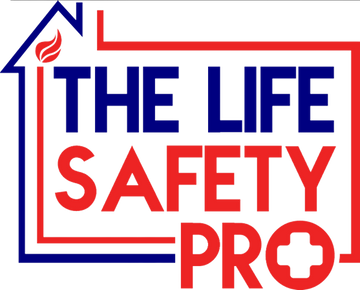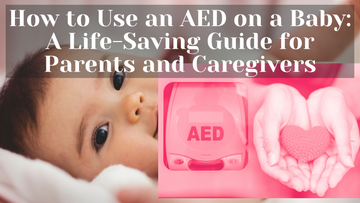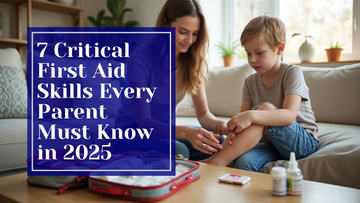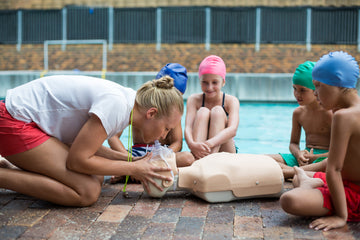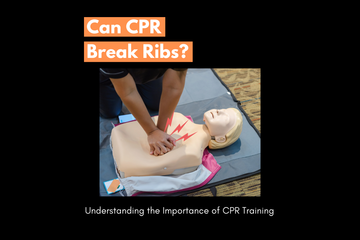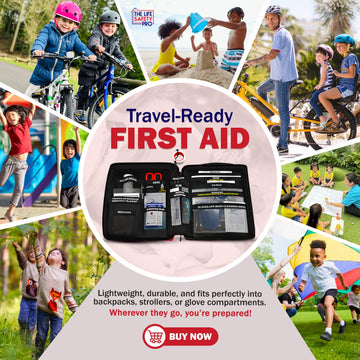
Essential Child Safety and First Aid Training You Need!
Learn essential child safety and first aid training to protect your family. Equip yourself with skills and knowledge for any emergency.
In today's world, ensuring the safety of our children is more crucial than ever. Understanding the importance of child safety training can empower parents and caregivers to take proactive measures in safeguarding their loved ones. This training not only focuses on basic first aid skills but also covers prevention strategies that can avert potential accidents.
Child safety training encompasses various aspects, including:
-
Emergency Preparedness: Knowing how to respond effectively in emergencies such as choking, burns, or cuts is vital. Training equips you with the skills to act quickly, which can make a significant difference.
-
Accident Prevention: Understanding how to create a safe environment for children—whether at home, in the playground, or while traveling—helps minimize risks.
-
Building Confidence: Parents and caregivers trained in first aid and life safety feel more confident in handling emergencies, reducing panic during critical situations.
By taking the time to invest in child safety and first aid training, you are not only enhancing your knowledge but also promoting a culture of safety within your family. This training is an invaluable resource that can help prevent injuries and save lives.
Keep your Kids Safe! Click now to get our Children's First Aid Kits on Amazon and be prepared! Children's First Aid Kit
Key First Aid Skills Every Parent Should Know

Every parent should be equipped with essential first aid skills to respond effectively to minor injuries and emergencies that children may face. These skills not only provide immediate assistance but also aid in preventing further complications. Here are some key first-aid skills every parent should know:
- CPR (Cardiopulmonary Resuscitation): Knowing how to perform CPR can be a lifesaving skill. Parents must understand the steps for infants, children, and adults, as the techniques vary slightly based on age.
- Choking Relief: Children often explore their surroundings by putting objects in their mouths, which can lead to choking hazards. Learning Abdominal Thrusts and Back Blows can help dislodge food or objects stuck in an Infant's throat.
- Wound Care: Familiarity with how to clean and dress various types of wounds, including cuts and abrasions, is important. This prevents infections and promotes healing.
- Managing Burns: Understanding the different types of burns and knowing how to treat them properly can prevent complications. It’s vital to know when to seek medical attention.
- Recognizing Allergic Reactions: Being able to identify signs of severe allergic reactions, such as swelling, hives, vomiting, or difficulty breathing, is crucial. Parents should know how to use an EpiPen if their child has a known allergy.
These skills are foundational for any parent or caregiver, as they can significantly impact the outcome in emergencies. Investing time in learning and practicing these skills can make a world of difference in ensuring your child's safety.
Recognizing Common Childhood Injuries and Emergencies

Understanding the common injuries and emergencies that children may experience is crucial for every parent. Children are naturally curious and active, which often leads to accidents. Here are some of the most prevalent childhood injuries and emergencies that parents should recognize:
- Falls: Falls are among the most common causes of injuries in children, often resulting in bruises, scrapes, or more serious injuries like fractures. Parents should be vigilant about providing a safe environment and supervising their children during play.
- Burns: Burns can occur from hot liquids, flames, or even sun exposure. Recognizing the signs of a burn and knowing how to treat it can prevent further injury and complications. Make sure you run the burn under cool water.
- Cuts and Scrapes: Children often get cuts and scrapes from various activities. It's essential to clean the wound properly and monitor for signs of infection.
- Allergic Reactions: Kids can develop allergies to food, insect stings, or environmental factors. Being aware of the signs of an allergic reaction, such as hives or difficulty breathing, is vital for prompt treatment.
- Choking: Young children may choke on toys, food, or small objects. Recognizing the signs of choking and knowing how to respond can save a child's life.
- Head Injuries: With active play comes the risk of head injuries, which can range from minor bumps to concussions. Understanding the symptoms of a concussion and when to seek medical help is essential.
Parents can act swiftly and effectively by being aware of these common injuries and emergencies, ensuring their children's safety. Regularly updating your knowledge about childhood injuries will empower you to respond confidently in times of need.
Creating a Family Emergency Plan for Safety

Creating a family emergency plan is a critical step in ensuring the safety of your loved ones. A well-thought-out plan prepares your family for various emergencies, from natural disasters to medical incidents. Here’s how to create an effective family emergency plan:
- Identify Potential Emergencies: Consider the types of emergencies that could occur in your area, such as earthquakes, floods, fires, or severe weather. Understanding these risks allows you to tailor your plan to your specific needs.
- Establish a Communication Plan: In the event of an emergency, it’s crucial to have a designated point of contact. Ensure every family member knows how to reach this person or where to meet if separated.
- Designate Safe Locations: Choose safe spots in and out of your home for family members to gather in case of an evacuation. Ensure everyone knows these locations. Also include locations in multiple locations; this way, if your primary location is blocked, you will have an alternative route.
- Gather Emergency Supplies: Assemble an emergency kit with first aid supplies, water, non-perishable food, flashlights, and essential documents. Regularly check and update these supplies.
- Practice Your Plan: Conduct regular drills with your family to practice your emergency plan. This can help everyone feel more confident and prepared to react in real situations.
- Teach Safety Skills: Educate your family about basic safety skills such as CPR, first aid, and how to use a fire extinguisher. Empowering your family with knowledge can be crucial in emergencies.
Creating a comprehensive family emergency plan ensures that everyone knows their role and responsibilities, leading to a more organized and effective response during an emergency. Remember, preparation is key to safety!
Choosing the Right First Aid Kit for Families
Choosing the right first aid kit for your family is essential to ensure you are prepared for any minor injuries or medical emergencies. A well-stocked first aid kit can make a significant difference in effectively addressing injuries and providing immediate care. Here are some important factors to consider when selecting a family-friendly first aid kit:
- Size and Portability: Depending on your family's needs, consider whether you need a small, portable kit for outings or a larger kit for home use or camping activites. A compact kit is ideal for travel, while a larger kit should be accessible in your home.
- Contents: Look for a kit that includes essential items such as adhesive bandages, antiseptic wipes, gauze pads, large scissors, stainless-steel tweezers, and a CPR face shield or mask. Ensure it also has extra room for age-appropriate medications for your family members, such as your favorite children's pain relievers.
- Durability: A good first aid kit should be made of sturdy materials that protect the supplies from moisture and damage. It should be easy to open.
- Clear Organization: Choose a kit with individual compartments of labeled sections, making it easy to find what you need in an emergency. An organized kit allows for quicker response times. Also having labeled compartments will make it easier for you to restock your first aid kit.
- Customizability: Every family has unique needs, so look for kits that allow you to add or modify supplies based on your preferences. Consider including items like allergy medications, specific bandages, or even emergency contact information.
By carefully selecting the right first aid kit for your family, you can ensure that you are well-prepared to handle various situations. A well-stocked and organized first aid kit can be a lifesaver in emergencies, providing peace of mind for parents and caregivers alike.
If you don't want to keep searching our Children's First Aid kits will fit what you need for every occasion. There are 3 different sizes to meet your needs. You can learn more about our Children's First Aid Kit HERE.
Accessing Resources for Ongoing Safety Education

Accessing resources for ongoing safety education is crucial for parents and caregivers who want to stay informed about best practices in child safety and first aid. Continuous learning not only enhances your skills but also boosts your confidence in handling emergencies. Here are several ways you can access valuable resources:
- Online Courses: Numerous organizations offer online courses in child safety and first aid training. These courses are often interactive and can be completed at your own pace, making them ideal for busy families.
- Local Workshops: If you are located in the Pittsburgh, PA area we offer first aid and child safety training course that come to you. Participating in these hands-on sessions can provide practical experience and allow you to ask instructors questions directly. You can also check with your local Fire / EMS agencies and hospitals to find a training near you.
- Books and Manuals: Investing in comprehensive first aid manuals or books focused on child safety can serve as excellent reference material. Did you know our Children's First Aid Kit comes with a customize first aid guide directed to help you with your common child injuries. Its in an easy to follow format of what you see and what you do.
- Online Resources: Websites like The Life Safety Pro provide informative articles, tips, and checklists that are easy to understand. Subscribing to our newsletter can keep you updated on new safety practices and emerging trends.
- Community Support Groups: Joining local parenting groups or online forums can be beneficial. These groups often share resources, experiences, and advice on child safety, creating a supportive environment for caregivers. Check out Our Children's First Aid Goup on Facebook
By actively seeking out these resources, you can stay informed and prepared. Remember, safety education is an ongoing process that evolves as your children grow. Keep your Kids Safe! Click now to get our Children's First Aid Kits on Amazon and be prepared! www.thelifesafetypro.com
